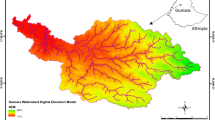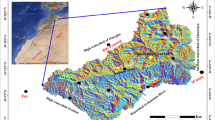Abstract
Hydrological indices provide excellent input to geographic information systems for the successful mapping of erosion-prone areas. In this research, a digital elevation model was processed and analyzed to obtain the necessary hydrological indices necessary for erosion modeling. The indices (such as sediment transport index, compound topography index, and stream power index) along with other themes (Like Slope gradient, curvature, distance to channels, and channel density) were overlaid using the “Weighted Sum” overlay tool in the geographic information system. The results showed that 33.14 km2 of the test watershed (sub-basin of Abay, Ethiopia) falls in very high/severe erosion zone and needs immediate conservation measures. A total of 98.26 km2, 153.40 km2, and 263.17 km2 fall in high-, moderate-, and low-erosion hazard zones, respectively. Therefore, the primary and secondary derivatives of the digital elevation model along with morphometric parameters coupled with a Spatial Analyst tool proves to be a powerful integrated approach in demarcating erosion vulnerable zones and could be applied at regional and continental scale for proper watershed management.












Similar content being viewed by others
References
Ahmad, I. (2018). Digital elevation model (DEM) coupled with geographic information system (GIS): an approach towards erosion modeling of Gumara watershed, Ethiopia. Environmental Monitoring and Assessment, 190, 568. https://doi.org/10.1007/s10661-018-6888-8.
Burt, T., & Butcher, D. (1986). Stimulation from simulation: a teaching model of hillslope hydrology for use on microcomputers. Journal of Geography in Higher Education, 10, 23–39.
Chen, T., Niu, R. Q., Li, P. X., Zhang, L. P., & Du, B. (2011). Regional soil erosion risk mapping using RUSLE, GIS, and remote sensing: a case study in Miyun watershed. North China. Environmental Earth Sciences, 63, 533–541.
Dabral, P. P., Baithuri, N., & Pandey, A. (2008). Soil erosion assessment in a hilly catchment of North Eastern India using USLE, GIS and remote sensing. Water Resources Management, 22(12), 1783–1798.
Dymond, J. R., & Harmsworth, G. R. (1994). Towards automated land resource mapping using digital models. ITC Journal, 2, 129–138.
Eswaran, H., Lal, R., & Reich, P. F. (2001). Land degradation: an overview. In E. M. Bridges, I. D. Hannam, L. R. Oldeman, F. W. T. Penning-de-Vries, S. J. Scherr, & S. Sombatpanit (Eds.), Response to land degradation (pp. 20–35). Enfield, NH, USA: Science Publishers Inc..
Lal, R. (2001). Soil degradation by erosion. Land Degradation and Development, 12(6), 519–539.
Lehmann J. G. (1816). Die Lehre der Situation- Zeichnung, oder Anweisung zum richtigen Erkennen und genauen Abbilden der Erdoberfläche in topographischen Karten und Situation-Planen.
Lin, S., Jing, C., Coles, N. A., Chaplot, V., Moore, N. J., & Wu, J. (2013). Evaluating DEM source and resolution uncertainties in the Soil and Water Assessment Tool. Stochastic Environmental Research and Risk Assessment, 27(1), 209–221.
Mondal, A., Khare, D., Kundu, S., Meena, P. K., Mishra, P. K., & Shukla, R. (2014). Impact of climate change on future soil erosion in different slope, land use, and soil-type conditions in a part of the Narmada River Basin. India Journal of Hydrologic Engineering, 20, C5014003. https://doi.org/10.1061/(ASCE)HE.1943-5584.0001065.
Moore, I. D., Grayson, R. B., & Ladson, A. R. (1991). Digital terrain modeling: a review of hydrological, geomorphological, and biological applications. Hydrological Processes, 5, 3–30.
Moore, I. D., Gessler, P. E., Nielsen, G. A., & Peterson, G. A. (1993). Soil attribute prediction using terrain analysis (Vol. 57, pp. 443–452). Soil Science Society of America Journal.
Pan, J., & Wen, Y. (2014). Estimation of soil erosion using RUSLE in Caijiamiao watershed, China. Natural Hazards, 71(3), 2187–2205.
Smith, M. J., Goodchild, M. F., Longley, P. A. (2012) Geospatial analysis: a comprehensive guide, Electronic book. https://arxiv.org/ftp/arxiv/papers/1902/1902.06672.pdf.
Vrieling, A., (2007) Mapping erosion from space. Ph.D. Thesis Wageningen University, Germany, ISBN 978–90-8504-587-8.
Author information
Authors and Affiliations
Corresponding author
Additional information
Publisher’s note
Springer Nature remains neutral with regard to jurisdictional claims in published maps and institutional affiliations.
Rights and permissions
About this article
Cite this article
Ahmad, I., Dar, M.A., Teka, A.H. et al. Application of hydrological indices for erosion hazard mapping using Spatial Analyst tool. Environ Monit Assess 191, 482 (2019). https://doi.org/10.1007/s10661-019-7614-x
Received:
Accepted:
Published:
DOI: https://doi.org/10.1007/s10661-019-7614-x




